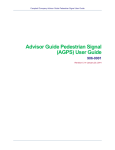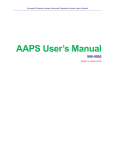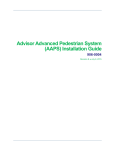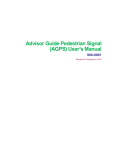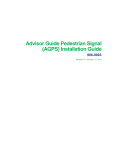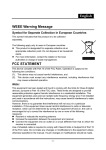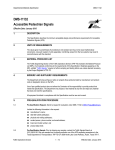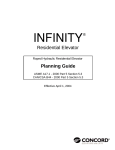Download Advisor Guide Pedestrian Station User`s Manual 6-19-2012
Transcript
Campbell Company Advisor Guide Pedestrian Signal User Guide Advisor Guide Pedestrian Signal (APGS) User Guide 906-0001 Revision A ● June 19, 2012 This User Guide provides instructions on how to use the application Campbell Company AGPS User Manual Campbell Company 450 W. McGregor Drive Boise, Idaho 83702 USA Tel: +1-208-345-7459 Fax: + 1-208-345-7481 Last edited: 19 June 2012 This document is copyright © 19 June 2012 by Campbell Company. All rights reserved. No part of this publication may be reproduced, transmitted, transcribed, stored in a retrieval system, or translated into any language, in any form or by any means, electronic, mechanical, photocopying, recording, or otherwise, without prior written permission from Campbell Company. All copyright, confidential information, patents, design rights and all other intellectual property rights of whatsoever nature contained herein are and shall remain the sole and exclusive property of Campbell Company. The information furnished herein is believed to be accurate and reliable. However, no responsibility is assumed by Campbell Company for its use, or for any infringements of patents or other rights of third parties resulting from its use. The Campbell Company name and Campbell Company logo are trademarks or registered trademarks of Campbell Company. All other trademarks are the property of their respective owners Document Name: Advisor Guide Operational Manual © Company 2012. All rights reserved. Page 2 of 19 Campbell Company AGPS User Manual Advisor Guide Accessible Pedestrian Signal Owner’s Manual 906-0001 Revision: A Date: June 19, 2012 Document Revision History Revision Description Date Rev A New Release 6-18-2012 Software/ Firmware Version Version Version Update Revised By Date Utility 1.0.1 tbrennan 6-19-2012 Firmware 1.0.1 tbrennan 6-19-2012 Document Name: Advisor Guide Operational Manual © Company 2012. All rights reserved. Page 3 of 19 Campbell Company AGPS User Manual Table of Contents 1 Introduction............................................................................................................. 5 1.1 PURPOSE.................................................................................................................................... 5 1.2 SCOPE ....................................................................................................................................... 5 1.3 SYSTEM ORGANIZATION ............................................................................................................... 5 2 Features ................................................................................................................. 6 2.1 PRODUCT OVERVIEW ................................................................................................................... 6 2.2 COMPONENTS ............................................................................................................................. 7 2.3 SYSTEM OPERATIONS .................................................................................................................. 8 3 Installation .............................................................................................................. 9 3.1 INSTALLING THE SYSTEM ............................................................................................................... 9 3.2 SYSTEM OPERATIONAL CHECK FOLLOWING INSTALLATION ............................................................... 9 4 System Configuration ........................................................................................... 11 4.1 ERRORS, MALFUNCTIONS, AND EMERGENCIES .............................................................................. 16 5 Appendix A: Acronyms, Abbreviations & Definitions ............................................ 17 6 Appendix B: Related Documentation.................................................................... 19 6.1 OBTAINING DOCUMENTATION ...................................................................................................... 19 Page 4 of 19 Document Name: Advisor Guide Operational Manual © Company 2012. All rights reserved Campbell Company AGPS User Manual 1 Introduction 1.1 Purpose The purpose of this document is to define the functionality, operations, and maintenance of the Advisor Guide Accessible Pedestrian Signal. This document serves as the sole reference for the scope of the system functionality to be delivered by Campbell Company. Any change to the scope of the project or the Functional Specifications will require agreement via the change control process defined in the agreement between Campbell Company and the end user. 1.2 Scope This document will explain the software, functionality, installation, maintenance, and safety requirements associated with the Advisor Guide Pedestrian Signal. 1.3 System Organization The Advisor Guide Accessible Pedestrian Signal is an independent Accessible Pedestrian Signal device that interfaces over a USB configuration utility that runs on any Windows XP (or higher) with .net 4.0+ or UNIX like systems operations software device. AGPS - Advisor Guide Pedestrian Signal SPI - Signal Power Interface Base Stations Utility – Rev 1.0.1 Firmware # - 1.0.1 Page 5 of 19 Document Name: Advisor Guide Operational Manual © Company 2012. All rights reserved Campbell Company AGPS User Manual 2 Features 2.1 Product Overview The Advisor Guide Pedestrian Signal (APGS) is a fully integrated accessible pedestrian station (FIPS) that provides the pedestrian with visual, tactile and audible information about the intersection crossing at the pedestrian station. The AGPS is designed to monitor the CMU output signal to the walk display while utilizing the existing wires from the traffic control cabinet. A locator tone, controlled with ambient gain compensation, tells a pedestrian that the crossing is equipped with APS and where it can be found. An extended press provides specific intersection information and access to additional functions. The audible walk tone or message is accompanied by a vibro-tactile indication during the visual walk display. Optional clearance phase indications may provide additional information to the pedestrian where appropriate Each Advisor Guide Pedestrian Signal is configured at the factory, but customization and set-up are simply obtained through its USB port and a laptop. A computer utility allows the user to change settings for customization. Please carefully read the contents of this manual in its entirety so you fully understand the many functions and options the system provides. Standard Features Page 6 of 19 Independent time of day/night mode volume settings for locator tone and audio outputs Independent non-locator AGC and locator AGC settings Maximum volume dynamic range 0 – 100dB Audio output options – Default plus four options Synchronicity- Beaconing or group walk Button rated at 100 x 10⁶ actuations Utility for data and audio file transfer Report download capability in .csv format Document Name: Advisor Guide Operational Manual © Company 2012. All rights reserved Campbell Company AGPS User Manual Custom Message and Sound Options The Advisor Guide APS comes fully programmed with audio files from the factory but we give you the option to create your own custom messages in a simple .wav format that can be easily uploaded via USB port from any computer. Second languages, gender narrative, and special percussive tones can be easily created and uploaded. Locator Tone Acknowledgement Location Message Walk Phase Message Specifications Advisor Guide Base Station See product drawing/specifications and electrical requirements for Base Station Signal Power Interface (SPI) See product drawing/specifications and electrical requirements for SPI 2.2 Components Each Advisor Guide Accessible Pedestrian Signal includes the following: Page 7 of 19 Base Station – Pedestrian Push Button Station with 4 conductor cable Signal Power Interface (SPI) – Power supply for Base Station AGPS Utility – Operational Utility Adaptor plate – Mounts Pedestrian signs in various dimensions USB Cable –Type B (One per installation) Sign Mounting hardware Installation instructions Document Name: Advisor Guide Operational Manual © Company 2012. All rights reserved Campbell Company AGPS User Manual USB Configuration Utility A computer based USB configuration utility for Windows (XP or higher w/net 4.0) or UNIX like operational software is recommended. A USB cable (type B) connection is required for the base stations port connection. Mounting Requirements The AGPS requires two mounting holes tapped to secure the Base Station to the utility pole run. A 4-conductor cable run is required from the Signal Power Interface (SPI) which resides in the Pedestrian Signal Head to the base station. 2.3 System Operations The AGPS utility is a user friendly application that communicates to the CPU internal to the Base Station. Secure configuration prevents unauthorized tampering with settings and operational modes. The utility is easily launched from the computer giving the user full access to all features and configurations. Hover tool tips appear with each setting in the utility providing information about the desired functionality. Utility Version The Utility Version Number can be found in the Utility under Other => About. Utility Updates Contact Campbell Company for the latest AGPS Utility version updates and installation instructions Page 8 of 19 Document Name: Advisor Guide Operational Manual © Company 2012. All rights reserved Campbell Company AGPS User Manual 3 Installation 3.1 Installing the system Installation of the AGPS requires placement of the SPI in the Pedestrian Signal Head and the Base Station on a utility pole. A four conductor cable must be routed between each Base Station and its associated SPI. The Base Station replaces any existing pedestrian push button mounted on to the poles, and connects to the push button wires. The four conductor cable from the Base Station connects to the SPI’s 12 VDC terminals. From the pedestrian signal head’s display power terminal, a #16 AWG stranded wires is supplied for connection to the 120 VAC Walk/Don’t Walk and Common to the 120 V terminals on the SPI. If the sync function is desired between two stations, both stations must be on same pedestrian call circuit. Installation of an AGPS station utilizing a two man crew approximately 45 minutes to 1 hour (assuming no complications) SEE INSTALLATION MANUAL FOR DETAILED FOR DETAILED INSTALLATION INSTRUCTIONS. 3.2 System Operational Check Following Installation 1. The AGPS comes fully configured at the factory. When first powered up, an audible locator tone will be present. By removing the USB port cover at the side of the Base Station, a red LED (System On) just below the port should be flashing continuously in the Base Station cavity. 2. Depress the push button and verify the red LED turns on with an audible message “Wait”. If field wires from the traffic controller are connected to the station, verify that ped call is transmitted to the traffic controller. 3. When the Walk Signal is On, verify the Walk Phase message or percussive tone is present and the vibro-tactile button vibrates concurrently. 4. Repeat again with 2 second extended press and verify the red LED turns on with an audible location message, “Wait to Cross”. 5. After the Walk Phase message, verify an audible locator tone is present at the clearance phase (Flashing Don’t Walk). 6. Recheck all units for a full cycle to ensure all options and features operate as desired. Page 9 of 19 Document Name: Advisor Guide Operational Manual © Company 2012. All rights reserved Campbell Company AGPS User Manual 7. Depending on intersection location, factory default settings for volume, AGC, and vibotactile settings may require modifications. Proceed to the System Configuration section for details. 8. When you are satisfied that all units are working properly, install signs on each Base Station. Page 10 of 19 Document Name: Advisor Guide Operational Manual © Company 2012. All rights reserved Campbell Company AGPS User Manual 4 System Configuration The AGPS comes with a user friendly utility that configures each station effortlessly. While the APGS comes configured from the factory, some installations require modifications to audible messages or functionality to best fit the needs of the cross walk location. The configuration utility can be downloaded and launched on any number of computers that will be used in the field. A directory of sound files will need to be placed on each of the respective laptops for access. Before establishing communications with the Base Station, open up and launch the utility. (See Figure 1) Locate the Com Port selection box on the top of main configuration tab. Use the arrow to note the different number of Com Ports identified internal to your PC by the utility. Note: A Com Port is used for data transfer with serial devices. Some computers may have several com ports internally. Remove the USB port cover on the side of the Base Station. With the utility menu opened, plug in the USB cable into the port. Once again at the Com Port Selection box scroll down and a new Com Port will appear – select it. This is the Com Port for the AGPS serial communication. To down load the factory settings from AGPS, click on the large Download Button at the bottom left hand corner. The values from the Base Station are now available in the utility for viewing, modification, or to be saved in a directory to be used in other stations. To submit changes in the settings from the utility to the AGPS controller, click on the large Upload button on the bottom right hand corner. The values from the utility are now uploaded into the Base Station. Failure to upload will result in unchanged setting in the base station. Once the utility is closed all modified values are lost unless they are saved. To save the configurations, click on File => Save Configuration. This will the save the values in a directory for future applications. This is beneficial for modifying multiple stations at different locations without having to reconfigure the utility for each station manually. Numerous Configurations can be saved on the Computer for future use. To access a configuration, click on file => Open Configuration Page 11 of 19 Document Name: Advisor Guide Operational Manual © Company 2012. All rights reserved Campbell Company AGPS User Manual Advisor Guide Utility Configuration Figure 1.0 Page 12 of 19 Document Name: Advisor Guide Operational Manual © Company 2012. All rights reserved Campbell Company AGPS User Manual Setting and Operational Mode Features On the main configuration page is where the settings reside. Mode: APS Operational function. Off – No audible, visual, or tactile output Default – Full APS functionality EPAPS: Extended Press APS – Extended press activates APS features Vib Call Pulse: Vibro-tactile feedback at push button when depressed Recall: Places a call every cycle. Clearance Interval: Nothing: Default – independent operation Destination Beaconing – Destination station provides target beaconing for pedestrian to locate Walk Timeout: Maximum time in seconds for walk message to play Locator Period: Time in seconds between locator repetitions Sync Call: Synchronize outputs of two pedestrian stations None – Acts like and independent station Regular Press - Target station acts as if a regular Press were made Extended Press – Both stations activate as if an extended press were made VIB Intensity: Adjust the vibration intensity of the Walk indication Volume: Two setting to adjust volume for audible and locator tone independently Volume – Adjusts the volume of the audible messages or percussive tones Locator – Adjusts the locator volume Night Mode - Sets independent volume settings by time of day for locator and audible messages Start - Begin night mode volume settings End – Terminates night mode volume settings AGC: Volume increase Non Locator AGC – Adjusts the response for audible messaging independently Locator AGC – Adjusts the response of the locator tone independently Page 13 of 19 Document Name: Advisor Guide Operational Manual © Company 2012. All rights reserved Campbell Company AGPS User Manual Decrease Limit – Maximum that AGC is allowed to decrease Increase Limit – Maximum that AGC is allowed to increase Location: City, State Intersection: Cross Street for reference CC#: Used to identify Campbell Company SO# for customer for information regarding intersection How to Create and Update Audio Files in the AGPS The Advisor Guide APS comes fully programed with audio files from the factory. From the intersection worksheet submitted to at the time of purchase, Campbell Company records custom message about the intersection. An electric copy of audible files is sent to the customer at time of delivery and should be kept for future use. In addition, a full audio library is available at Campbell Company should your requirements change or by request of pedestrians. We provide English and Spanish messages, male or female voices, and an array of tones for your required specification. Campbell Company uses a .wav file format for its audio messaging and recommends this format if you decide to create your own. The utility will accept any recording sample of bit rate, however for optimal recording performance contact Campbell Company’s technical support for tips and on best known methods for optimal recording. Note: The summation of all audio files used cannot exceed 27sec. This will result in an error while downloading audio files into the utility. Free audio and recording programs (Audacity) are available on the web. A studio quality microphone and an area that is isolated from external noise is beneficial to record quality messages. Audio files are easily transferred from the utility with a click of a button. To change an audio file, click => Audio File tab in the utility (See Figure 2) – here you have the ability to change the following files: 1. Locator 2. Acknowledgement 3. Location 4. Walk 5. Destination Beacon The audio files must be available on the computer. To select an audio file, simply click the open button next to the desired audio file and select. When changing single or multiple audio files, a complete packet of must be selected (locator, acknowledgement, location, and walk) and saved Page 14 of 19 Document Name: Advisor Guide Operational Manual © Company 2012. All rights reserved Campbell Company AGPS User Manual in to a file. This will allow for use on multiple stations without have to create a new one for each station (Once you have completed this for the remaining files, save it to your computer then upload it to the Base Station. A Tone Generator function is available for building customized tones. At the top of the utility select =>Other, then Make Tone File. Here you have the option to choose the frequency and duration. If for some reason you need to restore the factory default audio messages, you can easily upload the files. Campbell Company also keeps a copy of the original audio files for record. Advisor Guide Utility: Audio Files Fig. 2 How to Set Time on the Utility To change or set time, click => Misc tab in the utility (See Figure 3) Page 15 of 19 Document Name: Advisor Guide Operational Manual © Company 2012. All rights reserved Campbell Company AGPS User Manual Read Time – Reads time from the Base Station Set PC Time – Sets time from PC Set Time – Sets time manually Utility Version Upgrades To download the latest utility versions contact Campbell Company for an electronic copy. Open Hex – Select latest utility version Advisor Guide Utility: Misc. Fig. 3 4.1 Errors, Malfunctions, and Safety Features Within each Base Station is an independent microcontroller which continuously checks for the state of the Walk and Don’t Walk status from the Pedestrian Signal Head. In an event the Advisor Guide sees a conflict, it will turn off all pedestrian crossing indications (vibro-tactile motor, turn off speaker, and stop any audio output) and remain silent. Page 16 of 19 Document Name: Advisor Guide Operational Manual © Company 2012. All rights reserved Campbell Company AGPS User Manual 5 Appendix A: Acronyms, Abbreviations & Definitions Term Meaning Accessible Pedestrian Signal A device that communicates information about pedestrian signal in a non-visual format such as audible tones, verbal messages, and/or vibrating surfaces (MUTCD) Adapter Plate An aluminum plate that mounts to the base station to display crosswalk signs. Audible Beaconing Use of sound to provide directional orientation and alignment information in the clearance phase. Audio File A file format for storing digital audio data on a computer system. Automatic Gain Control (AGC) An APS volume control that is automatically responsive to ambient (background) sound. Base Station Fully integrated APS station that contains the Mico-controller, push button, speaker, adapter plate Clearance Interval Indicator Tones sounding during the pedestrian clearance interval that are differentiated from the WALK interval indicator (tones) COM Port Serial communication port Conflict Monitor Unit The CMU monitors the outputs of the traffic controller, and if a fault is detected, the CMU puts the intersection to FLASH, with all red lights flashing, rather than displaying a potentially hazardous combination of signals. Extended Press On APS, holding the pedestrian push button down from 1-3 seconds may activate special features, including audible beaconing and extended pedestrian clearance interval. Page 17 of 19 Document Name: Advisor Guide Operational Manual © Company 2012. All rights reserved Campbell Company AGPS User Manual Night Mode Ability to set volume by time of day Quiet Signal Technology Campbell Company’s audio output consist of three major component’s: Forward facing speaker, Rapid Decline AGC, Night mode sound reduction Signal Power Interface (SPI) Power Source that interfaces with Pedestrian Signal Head power for Base Station Interface. USB Port USB docking hub on Base Station Utility Application to interface with Base Station .wav file Waveform Audio File Format (WAV) is a Microsoft and IBM audio file format standard for storing audio Page 18 of 19 Document Name: Advisor Guide Operational Manual © Company 2012. All rights reserved Campbell Company AGPS User Manual 6 Appendix B: Related Documentation # Document Title Version Location 1 MUTCD 2009 MUTCD 2009 Edition 2 Americans with Disabilities Act 1996 ADAAG 3 Transportation of Canada 2008 TAC 6.1 Obtaining Documentation The following sections provide sources for obtaining documentation from Campbell Company. 6.1.1 World Wide Web You can access the most current AGPS technical documentation on the World Wide Web at the following site: http://www.pedsafety.com => Support tab. 6.1.2 Product Documentation Technical documentation will be sent electronically on the date your product ships. On-line technical documentation is also available at http://www.pedsafety.com 6.1.3 Documentation Feedback If you are reading Campbell Company product documentation on the Internet, you can submit technical comments on the support website. You can e-mail your comments to [email protected] To submit your comments by mail, use the response card behind the front cover of your document, or write to the following address: Attn: Publications Manager Campbell Company 450 West McGregor Drive Boise, Idaho 83705 We appreciate your comments. Page 19 of 19 Document Name: Advisor Guide Operational Manual © Company 2012. All rights reserved




















